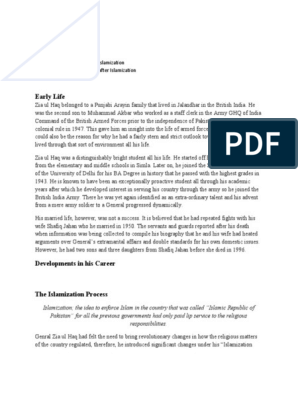PAKISTAN FOREIGN
POLICY
PHASE I: (1947-1953)
PHASE II: (1954-1962)
�Foreign Policy
Association or connections amongst sovereign
states.
Close association between sovereign states
covering their view points and outlooks on the
international affairs.
Is a product of ideological, historical, economic,
national interests and geo-political locations.
�Foreign Policy of Pakistan
Five FACTORS:
Ideological Obligation
Historical Legacy
Geographical Location
The Indian Threat
Economic Compulsions
�Phases of Foreign Policy of Pakistan
Phase I: 1947-53: Non Aliened years
Phase II: 1953-62: Alliance with the West
Phase III: 1962-71: Transition
Phase IV: 1972-79: Bilateralism and nonalignment
Phase V: 1980-90: Afghan-Crisis and US Ally
Phase VI:1990-2001: Post-Cold War Era and Pakistan's
Dilemmas
Phase VII: 2001-Date: Pakistan and Counter Terrorism
�Phase I: Foreign Policy of
Pakistan
Joined UN in Sep 30th, 1948
Relations with India (aftermath of partition)
Killing of people on both sides
Kashmir and other princely states (War 1948)
Water Dispute
Division of Funds
Division of Assets, etc.
�Phase I: Foreign Policy of
Pakistan
Relations with Afghanistan
Cordial representation in May 1948
Irredentist claim over Pakistan territory
Soviet Union backup in mid-1950
Reorganization of armed force
Due to Soviet backed Indo-Afghan military pressure
Modernization of three Services of Armed Forces
�Phase I: Foreign Policy of
Pakistan
Relation with US
Cordial relations resumed in Feb 1948
US Marshal Plan-1950 towards Asia
Liaqat Ali Khan visit to US in May 1950
Assistance in Economic Development
Become a prey to the US dictates
�Phase I: Foreign Policy of
Pakistan
Relation with USSR
Indifferent attitude towards Pakistan
Dec 1949, Pak Ambassador at Moscow
Invitation to Pakistan P.M. in June 1949
Accepted but did not accomplished
Anger of Soviet of Liaqat A. K. visit to US
�Phase I: Foreign Policy of
Pakistan
Relation with China
1st Muslim country to recognize China in Jan, 1950
Exchange of credentials in Sept, Nov, 1951
Backed Chinas entry into UN as against US
F.M. Manzoor Qadir criticized US to oppose China entry
1961, Ayub vote helped China to win a seat in UN
�Phase I: Foreign Policy of
Pakistan
Relation with Muslim Countries
Importance to Muslim relationship
Sponsored unofficial conferences for cultivating a broad-base setting
for Muslim organization.
Muslim states did not show any response
Indonesia and Egypt strong reservation on Pak
Cordial relations with Iran, Turkey and S. Arabia
�PHASE II: (1953-1962)
ALIENED YEARS
�Phase II: Foreign Policy of
Pakistan
Reasons:
Shift from Independent Policy to Alliance
Multifaceted alignments with the West
Security arrangements with US for economic and military assistance
Adverse effects of decrease in Jute and Cotton prices in international
market, 1952
Shortage of Wheat 1952-53
US wheat gift in 1953 to overcome shortage
�Phase II: Foreign Policy of
Pakistan
Continue
Sense of ISOLATION in the world
Futile efforts to promote Muslims UNITY
UN and commonwealth FAILURE in solving Pak-India conflicts,
especially Kashmir Dispute
Containment of DANGERs of Communism
Distrust of Soviet Union for a pro-Soviet Rawalpindi Conspiracy
Maj. G. Akbar Khan
Military willingness for advanced technology and economic support
�Phase II: Foreign Policy of
Pakistan
April 1954, Pak Turkey Agreement for political,
economic and cultural development
May 1954, Pak US Mutual Defense Assistance
Agreement , US shall provide equipment, trainings
and other services
Sep 1954, SEATO/ Manila Pact, alliance with US,
Australia, GB, NZ, Philippine, and Thailand)
To resist attacks and counter subversive
measures, promote economic and social welfare
Only for communist aggression and not all
Pakistans plea to include ALL was not accepted
�Phase II: Foreign Policy of
Pakistan
Sep 1955, Baghdad Pact (CENTO after Iraq withdrawal)
Attached greater importance because of 3
Muslim countries, Iraq, Turkey and Iran.
GB was a member whereas US back up
For strengthening defensive capabilities
For the menace of communism ONLY
�Phase II: Foreign Policy of
Pakistan
March 1959, Bilateral Agreement between Pak &
US
Defense and economic assistance from US
US national interest and Pak preservation of
independence and integrity
Provision of Air Base to US by Pakistan for 1959-69
800 million USD as assistance and loan
Ammunition, Artillery, Aircrafts, sea warships, etc.
US Military Assistance Advisory Group
Training of Military Officers in US
�Phase II: Foreign Policy of
Pakistan
Cost of Alignment with WEST
Independent Foreign Policy was compromised
Relations with Soviet Union
Threatening Pakistan for supporting US
Supporting India in Kashmir dispute
Support to Afghan irredentist claims
Pakistan exclusion from NAM in 1961 (due to defense pact)
Alienated Egypt, vague policy towards SUEZ crisis 1956
No support from US regarding Pak-India problems
Questions raised in US, Pak as defender of interests vs
USSR
�Phase II: Foreign Policy of
Pakistan
Pak China relations:
China avoid open condemnation of Pakistan
participation in the PACTs
Showed remarkable understanding of Pakistan position
Backed Up China in getting UN membership
Indo-Sino relationships helped Pakistan
Pak India relations:
Kashmir Dispute, Canal Water dispute
Indus Basin Water Treaty 1960






































































































